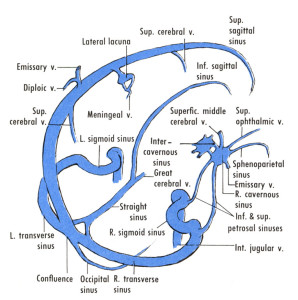

Cerebral venous drainage territories but can be represented in a scheme but may vary according to variant drainage.
Up to 30% of patients have a venous sinus hypoplasia or agenesia, especially the lateral sinuses. Therefore it is important to perform in the acute phase a RM study to assess the presence of acute thrombus. Also the sequence of angio-MRI or CT angiography show us the filling defect, but we can not say if it corresponds to a thrombosed vein or agenesia, therefore only T1-FLAIR and diffusion MRI sequences can corroborate this.

Press here to check recommendations of AHA/ASA⇐
https://www.ahajournals.org/doi/epub/10.1161/STROKEAHA.119.025334 ⇐Click here too, recommendations of AHA/ASA en TVC
Etiologies of cerebral venous thrombosis:
| Thrombophilia |
| Deficiencies of antithrombin, protein C, and protein S |
| Factor V Leiden mutation |
| Prothrombin gene mutation 20210 |
| Antiphospholipid antibodies |
| Hyperhomocysteinemia |
| Women’s health concerns |
| Pregnancy |
| Postpartum state |
| Hormonal contraceptive or replacement therapy |
| Infection |
| Localized infections such as otitis, mastoiditis, sinusitis |
| Meningitis |
| Systemic infectious disorders |
| Chronic inflammatory diseases |
| Vasculitides |
| Inflammatory bowel disease |
| Cancer |
| Hematologic disorders |
| Polycythemia |
| Essential thrombocytosis |
| Paroxysmal nocturnal hemoglobinuria |
| Trauma |
| Head trauma |
| Local injury to cerebral sinuses or veins |
| Jugular venous cannulation |
| Neurosurgical procedures |
| Lumbar puncture |
| Nephrotic syndrome |